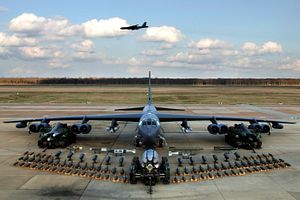The Pentagon is working on reconfiguring old warplanes and turning them into heavily armed “arsenal planes” to be deployed alongside fifth-generation fighter aircraft on combat missions, U.S. Defense Secretary Ashton Carter said in speech at the beginning of February, in which he discussed the Department of Defense’s 2017 budget.
Outlining projects that the Pentagon’s Strategic Capabilities Office (SCO) is working on, Carter said:
And the last project I want to highlight is one that we’re calling the arsenal plane, which takes one of our oldest aircraft platform and turns it into a flying launchpad for all sorts of different conventional payloads. In practice, the arsenal plane will function as a very large airborne magazine, network to fifth generation aircraft that act as forward sensor and targeting nodes, essentially combining different systems already in our inventory to create wholly new capabilities.
In order to remain stealthy, modern fighters such as the F-22 and F-35 have to carry all their weapons in internal bays, significantly reducing the payload they can carry. For example, the F-22 can fit four air-to-air missiles and two 1,000-pound bombs in its internal bay, whereas the F-35, next to two air-to-air missiles, can only carry two 2,000-pound bombs in its stealthiest configuration.
Legacy aircraft like the B-1 and B-52, however, can carry up to 75,000 pounds (34,000 kilograms) of weapons and are available in large numbers. The U.S. Airforce still operates 62 B-1B Lancer and 58 B-52 Stratofortress (with 18 in reserve).(Lockheed-Martin has built 195 F-22s, half the number requested by the Airforce, while the U.S. military has so far only received a little over 150 F-35 aircraft out of a total of 2,500 ordered.)
The arsenal plane/fifth-generation fighter jet interaction would be similar to the artillery observer and artillery battery in ground warfare: The fifth-generation aircraft will first identify and then direct fire from the arsenal plane unto a target. Depending on the battlefield environment, the arsenal plane would carry long-range standoff missiles such as the Joint Air to Surface Standoff Missile (JASSM) to in order to stay outside the enemy’s air defense perimeter, or — when engaging a technologically less advanced adversary — move closer and drop precision-guided bombs.
Incidentally, the U.S. Airforce announced in November 2015 that its B-52s will be armed with Lockheed Martin’s JASSM– Extended Range (JASSM-ER). However, Carter left it open what air platforms will be converted. Other options include cargo planes such as the C-130 Hercules and the C-17 Globemaster.
The concept of the arsenal plane is not new. During the 1990s, the U.S. Navy had the idea of building so-called “arsenal ships” — big ships stocked with hundreds of vertical launch cells and missiles — that would rely on other navy vessels to provide them with targeting information. Ultimately, the program was cancelled.
The SCO’s initiative is part of what has been called the third offset strategy, which, as I explained last week (See: “New US Defense Budget: $18 Billion for Third Offset Strategy”), “will not merely rely on new military technologies to guarantee military superiority in a future conflict but also focus on merging new with legacy technology, as well as new with old warfighting methods.”
Furthermore I explained: “There is little doubt that the Pentagon’s third offset strategy primarily aims to offset recent advances in military technologies made by China and Russia. The Pentagon lists both countries as two out of five strategic challenges that the United States will have to remain focused on in the new fiscal year.”
































